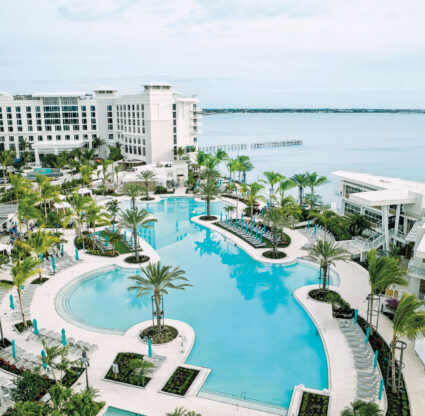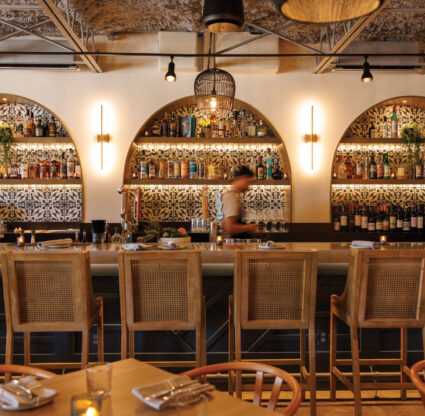Until about 20 years ago, Txakolina was mostly known only in its native region of Spanish Basque Country, which brushes up against the French border. There, the slightly spritzy white wine is served alongside tapas and seafood. Txakolina (pronounced chock-oh-lee-nah) is produced in northeastern Spain, just west of the gastronomic capital of San Sebastián, in the country’s first and largest wine region, Getariako Txakolina.
“Txakolina is getting more popular within the sommelier community, but it’s not something everyday wine drinkers may know about,” says sommelier Piotr Lewandowski, half of the wine team at Naples seafood institution USS Nemo. “It’s effervescent, but not a sparkling wine; it has a little spritz on the tongue with a really fresh nose. It feels like a nitrogen blanket on top of the wine.”
Piotr—who has been at the restaurant for about 15 years, since he moved from his home country of Poland after high school—works on the wine list alongside Québec City-born Éric Blais, who is also a certified sommelier and has been at USS Nemo nearly two decades. While the restaurant’s wine program has long been strong, it’s only recently, under new ownership, that they started putting their list forward for prizes like Wine Spectator’s Award of Excellence, which they received this year on their first try.
Piotr says it’s the diversity of their list (with selections from across France, Italy and Spain) and pricing (“We’re not on Fifth Avenue; we’re in a strip mall in the middle of U.S. 41.”) that make it stand out from others in the area. “Naples is still heavy on oaked Chardonnay and Cabernet—that’s what people are drinking and familiar with, but we try and step outside of the box,” he explains. “We don’t have typical mainstream wines on the menu.”
When selecting wines—especially by the glass—the duo tries to have an “alternative” white and red, ones from producers or varietals that diners might not necessarily know but would be curious to try. About six years ago, they started serving albariño, another coastal white wine made in Portugal and Spain. Three years ago, they introduced the dry white grüner veltliner, crafted primarily in Austria and parts of Eastern Europe.
In early summer, Mikel Txueka, one of the members of the family-run Txomin Etxaniz, brought in a bottle of the winery’s white Txakolina, and the somms were instantly intrigued. Txomin Etxaniz is the largest winery in the coastal town of Getaria and was part of the group that established the official Getariako Txakolina wine appellation in 1989. Crafted primarily from native white hondarrabi zuri grapes, the wine is fresh, light and floral. “It’s mineral with a little bit of spritz, and low in alcohol (between 9.5 and 11 percent)—it’s perfect with seafood and is a great summer wine,” Éric says.
The family has been producing wine in the windswept region near the Atlantic since around 1649, and the white Txakolina is crafted from 124 acres of historic, hillside vineyards that have been cared for by the Txuekas for generations. “Outside of Basque Country and Basque restaurants, this is not a wine you’ll find in a lot of places,” Mikel says, adding that they produced a mere 560,000 bottles of the 2021 vintage (compared to the millions of bottles produced by larger wineries), and 65 percent of total production is sold in the Basque area.
Back in 2001, only about 12,000 bottles of Txakolina were exported to the U.S., according to trade organization Foods and Wines From Spain. But in 2019, that number more than doubled to nearly 230,000. The Basque area’s rise as a culinary destination, consistently churning out legendary chefs and restaurants (many with Michelin stars), has also helped visitors discover Txakolina and want to relive their vacation by sipping the wines back home. “It’s growing because the market wants these kinds of lighter wines,” Mikel says.
At USS Nemo, the menu lends itself to fresh, easy wines like Txakolina, since the salinity acidity, dryness and low alcohol level pair beautifully with seafood like grilled Mediterranean octopus or sautéed calamari. “The wine is great with seafood and for the Florida palate, but I don’t think it’s going to get super popular or trendy anytime soon,” Piotr says. “But that’s why we’re including it—we want to introduce people to wines like that.”





